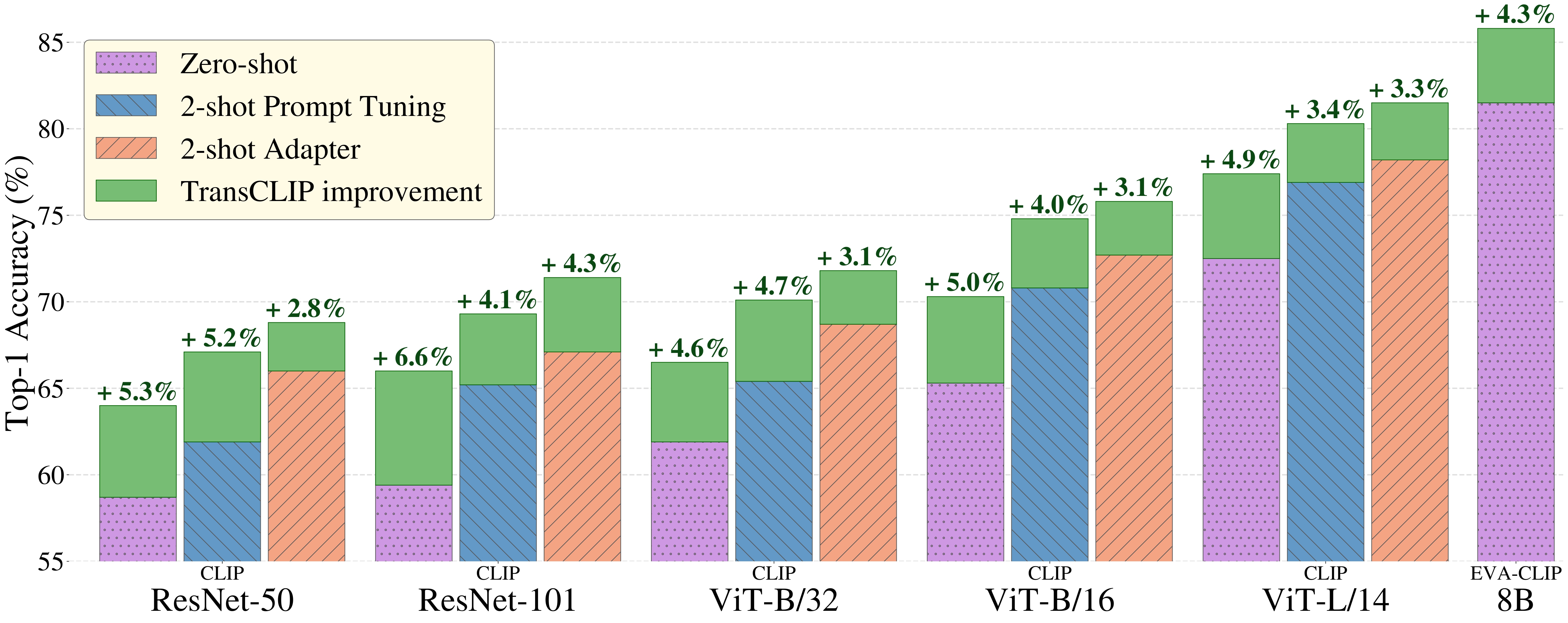The official implementation of Boosting Vision-Language Models with Transduction.
Authors: Maxime Zanella, Benoît Gérin, Ismail Ben Ayed.
We present TransCLIP, a novel and computationally efficient transductive approach designed for Vision-Language Models. TransCLIP is applicable as a plug-and-play module on top of popular inductive zero- and few-shot models, consistently improving their performances.

Figure 1: TransCLIP improves significantly zero-shot models and few-shot methods based either on adapter or prompt tuning for a large variety of encoders, with size up to 8 billion parameters.
🛰️ TransCLIP has successfully enhanced remote sensing Vision-Language Models, achieving an average accuracy improvement of over 10%.
Feel free to check the paper and the GitHub project !
🔬 TransCLIP has successfully enhanced histopathology Vision-Language Models, achieving an average accuracy improvement of over 6% on Quilt, 7% on CONCH and 10% on PLIP.
Feel free to check the paper and the GitHub project !
For those new to Transduction and/or Vision-Language Models, we invite you to explore our friendly guide for an accessible introduction to the essential aspects of our project.
This repository requires to install an environment and datasets:
Create a Python environment with your favorite environment manager. For example, with conda:
conda create -y --name TransCLIP python=3.10.0
conda activate TransCLIP
pip3 install -r requirements.txtAnd install Pytorch according to your configuration:
pip3 install torch==2.0.1 torchaudio==2.0.2 torchvision==0.15.2Please follow DATASETS.md to install the datasets. You will get a structure with the following dataset names:
$DATA/
|–– imagenet/
|–– caltech-101/
|–– oxford_pets/
|–– stanford_cars/
|–– oxford_flowers/
|–– food-101/
|–– fgvc_aircraft/
|–– sun397/
|–– dtd/
|–– eurosat/
|–– ucf101/
|–– imagenetv2/
|–– imagenet-sketch/
|–– imagenet-adversarial/
|–– imagenet-rendition/
If you'd like to apply TransCLIP on top of pre-computed prototypes, please download the textual features of CoOp and TaskRes on the 11 datasets in this Drive link and go to TransCLIP-ZS on top of few-shot learning method to use them properly with our code. See Contact if you have any inquiries about missing embeddings.
The drive is organized as follows:
Few-shot/method/: the few-shot method (coop, or taskres, ...)encoder/: architecture name (rn50, rn101, vit_b32, vit_b16, vit_l14), we recommend starting with vit_b16.Xshots/: number of shots (X=1,2,4,8,16).dataset/: name of the dataset (see above)seedY/: seed number (Y=1,2,3)text_features.pt: textual features
We present the basic usage to get started with our method. You have to pass the datasets folder path and the pre-computed prototypes folder path. Each script has pre-set parameters but you can change them manually.
TransCLIP-ZS based on the textual embeddings of the zero-shot model.
- Zero-Shot setting
Here is an example for the imagenet dataset, with the CLIP-ViT-B/16 architecture, and seed 1:
python3 main.py --root_path /path/to/datasets/folder --dataset imagenet --method TransCLIP --backbone vit_b16 --seed 1To run the whole experiment, use the following command:
bash ./scripts/transclip_zs.sh /path/to/datasets/folder vit_b16TransCLIP-FS based on the textual embeddings of the zero-shot model with additional shots (labeled support set).
- Transductive Few-Shot setting
Here is an example for the imagenet dataset, with the CLIP-ViT-B/16 architecture, 2 shots, and seed 1:
python3 main.py --root_path /path/to/datasets/folder --dataset imagenet --method TransCLIP --backbone vit_b16 --shots 2 --seed 1To run this experiment, use the following command:
bash ./scripts/transclip_fs.sh /path/to/datasets/folder vit_b16 2To execute TransCLIP-ZS on top of inductive few-shot methods (e.g. CoOp prompt).
- Few-Shot setting
In this setting, the test set should come from the same dataset as the training (support) set of the inductive few-shot method. To run this experiment, use the following command:
bash ./scripts/fewshot_atop.sh /path/to/datasets/folder /path/to/prototypes/folder vit_b16 coop 2- Cross-dataset setting
In this setting, the test set is typically different from the training (support) set of the inductive few-shot method (16-shot imagenet in our case). To run this experiment, use the following command:
bash ./scripts/crossdataset_atop.sh /path/to/datasets/folder /path/to/prototypes/folder vit_b16 coop- Domain-generalization setting
In this setting, the test set is typically another variant of imagenet while the inductive few-shot method was trained on imagenet (16-shot). To run this experiment, use the following command:
bash ./scripts/domaingeneralization_atop.sh /path/to/datasets/folder /path/to/prototypes/folder vit_b16 coopYou can run the transductive few-shot baselines by using (and modifying) the following command:
bash ./scripts/transductive_baselines.sh /path/to/datasets/folder vit_b16 transductive_finetuning 4You can select among {transductive_finetuning; bdcspn; laplacian_shot; ptmap; tim}.
This repository is mainly based on CoOp, Tip-Adapter and CLAP. Thanks for their great work!
If you find this repository useful, please consider citing our paper:
@article{zanella2024boosting,
title={Boosting Vision-Language Models with Transduction},
author={Zanella, Maxime and G{\'e}rin, Beno{\^\i}t and Ayed, Ismail Ben},
journal={arXiv preprint arXiv:2406.01837},
year={2024}
}
You can also cite our RS-TransCLIP paper:
@article{elkhoury2024enhancing,
title={Enhancing Remote Sensing Vision-Language Models for Zero-Shot Scene Classification},
author={Karim El Khoury and Maxime Zanella and Beno{\^\i}t G{\'e}rin and Tiffanie Godelaine and Beno{\^\i}t Macq and Sa{\"i}d Mahmoudi and Christophe De Vleeschouwer and Ismail Ben Ayed},
journal={arXiv preprint arXiv:2409.00698},
year={2024}
}
For any inquiries, please contact us at maxime.zanella@uclouvain.be and benoit.gerin@uclouvain.be or feel free to create an issue.